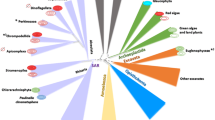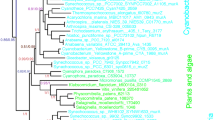Abstract
Conservation of Lethal-leaf spot 1 (Lls1) lesion mimic gene in land plants including moss is consistent with its recently reported function as pheophorbide a oxygenase (Pao) which catalyzes a key step in chlorophyll degradation (Pruzinska et al., 2003). A bioinformatics survey of complete plant genomes reveals that LLS1(PAO) belongs to a small 5-member family of non-heme oxygenases defined by the presence of Rieske and mononuclear iron-binding domains. This gene family includes chlorophyll a oxygenase (Cao), choline monooxygenase (Cmo), the gene for a 55 kDa protein associated with protein transport through the inner chloroplast membrane (Tic55) and a novel 52 kDa protein isolated from chloroplasts (Ptc52). Analysis of gene structure reveals that these genes diverged prior to monocot/dicot divergence. Homologues of LLS1(PAO), CAO, TIC55 and PTC52 but not CMO are found in the genomes of several cyanobacteria. LLS1(PAO), PTC52, TIC55 and a set of related cyanobacterial homologues share an extended carboxyl terminus containing a novel F/Y/W-x2-H-x3-C-x2-C motif not present in CAO. These proteins appear to have evolved during the transition to oxygenic photosynthesis to play various roles in chlorophyll metabolism. In contrast, CMO homologues are found only in plants and are most closely related to aromatic ring-hydroxylating enzymes from soil-dwelling bacteria, suggesting a more recent evolution of this enzyme, possibly by horizontal gene transfer. Our phylogenetic analysis of 95 extant non-heme dioxygenases provides a useful framework for the classification of LLS1(PAO)-related non-heme oxygenases.
Similar content being viewed by others
References
Altschul, S.F., Madden, T.L., Schäffer, A.A., Zhang, J.H., Zhang, Z., Miller, W. and Lipman, D.J. 1997. Gapped BLAST and PSI-BLAST: a new generation of protein database search programs. Nucl. Acids Res. 25: 3389–3402.
Balmer, Y., Koller, A., del Val, G., Manieri, W., Schurmann, P. and Buchanan, B.B. 2003. Proteomics gives insight into the regulatory function of chloroplast thioredoxins. Proc. Natl. Acad. Sci. USA 100: 370–375.
Batie, C.J., Ballou, D.P. and Correll, C.C. 1991. Phthalate dioxygenase reductase and related flavin-iron sulfur containing electron transferases. Chem. Biochem. Flavoenzymes 3: 543–556.
Beale, S.I. 1999. Enzymes of chlorophyll biosynthesis. Photosyn. Res. 60: 43–73.
Burnet, M., Lafontaine, P.J. and Hanson, A.D. 1995. Assay, purification and partial characterization of choline mononxygenase from spinach. Plant Physiol. 108: 581–588.
Caliebe, A., Grimm, R., Kaiser, G., Lubeck, J., Soll, J. and Heins, L. 1997. The chloroplastic protein import machinery contains a Rieske-type iron-sulfur cluster and a mononuclear iron-binding protein. EMBO J. 16: 7342–7350.
Cheng, W.-H., Im, K.H. and Chourey, P.S. 1996. Sucrose phosphate synthase expression at the cell and tissue level is coordinated with sucrose sink-to-source transitions in maize leaf. Plant Physiol. 111: 1021–1029.
Chivers, P.T., Prehoda, K.E. and Raines, R.T. 1997. The CXXC motif: a rheostat in the active site. Biochemistry 36: 4061–4066.
Espineda, C.E., Linford, A.S., Devine, D. and Brusslan, J.A. 1999. The AtCAO gene, encoding chlorophyll a oxygenase, is required for chlorophyllb synthesis in Arabidopsis thaliana. Proc. Natl. Acad. Sci. USA 96: 10507–10511.
Gray, J., Close, P.S., Briggs, S.P. and Johal, G.S. 1997. A novel suppressor of cell death in plants encoded by the Lls1 gene of maize. Cell 89: 25–31.
Gray, J., Janick-Buckner, D., Buckner, B., Close, P.S. and Johal, G.S. 2002. Light-dependent death of maize lls1 cells is mediated by mature chloroplasts. Plant Physiol. 130: 1–14.
Hall, B.G., 2001. Phylogenetic Trees Made Easy: A How-To Manual for Molecular Biologists. Sinauer, Sunderland, MA.
Harayama, S., Kok, M. and Neidle, E.L. 1992. Functional and evolutionary relationships among diverse oxygenases. Annu. Rev. Microbiol. 46: 565–601.
Hess, W.R., Rocap, G., Ting, C.S., Larimer, F., Stilwagen, S., Leamerdin, J. and Chisholm, S.W. 2001. The photosynthetic apparatus of Prochlorococcus: insights through comparative genomics. Photosyn. Res. 70: 53–71.
Hibino, T., Waditee, R., Araki, E., Ishiwaka, H., Kenji, A., Tanaka, Y. and Takebe, T., 2002. Functional characterization of choline monooxygenase, an enzyme for betaine synthesis in plants. J. Biol. Chem. 277: 41352–41360.
Hortensteiner, S., 1999. Chlorophyll breakdown in higher plants and algae. Cell. Mol. Life Sci. 56: 330–347.
Hortensteiner, S., Chinner, J., Matile, P., Thomas, H. and Donnison, I.S. 2000. Chlorophyll breakdown in Chlorella protothecoides: characterization of degreening and cloning of degreening-related genes. Plant Mol. Biol. 42: 439–450.
Incharoensakdi, A. and Wutipraditkul, N. 1999. Accumulation of glycinebetaine and its synthesis from radioactive precursors under salt-stress in the cyanobacterium Aphanothece halophytica. J. Appl. Phycol. 11: 515–523.
Jiang, H., Parales, R.E., Lynch, N.A. and Gibson, D.T., 1996. Site-directed mutagenesis of conserved amino acids in the alpha subunit of toluene dioxygenase: potential mononuclear non-heme iron coordination sites. J. Bact. 178: 3133–3139.
Karlsson, A., Parales, J.V., Parales, R.E., Gibbon, D.T., Eklund, H. and Ramaswamy, S. 2003. Crystal structure of naphthalene dioxygenase: side-on binding of dioxygen to iron. Science 299: 1039–1042.
Kauppi, B., Lee, K., Carredano, E., Parales, R., Gibson, D.T., Eklund, H. and Ramaswamy, S. 1998. Structure of an aromaticring-hydroxylating dioxygenase — naphthalene 1,2 dioxygenase. Structure 6: 571–586.
Kobayashi, T. and Ito, K., 1999. Respiratory chain strongly oxidizes the CXXC motif of DsbB in the Escherichia coli disulfide bond formation pathway. EMBO J. 18: 1192–1198.
Küchler, M., Decker, S., Hörmann, F., Soll, J. and Heins, L. 2002. Portein import into chloroplasts involves redox-regulated proteins. EMBO J. 21: 6136–6145.
Kuge, S., Arita, M., Murayama, A., Maeta, K., Izawa, S., Inoue, Y. and Nomoto, A. 2001. Regulation of the yeast Yap1p nuclear export signal is mediated by redox signal-induced reversible disulfide bond formation. Mol. Cell. Biol. 21: 6139–6150.
Lange, S. J. and Que, L. Jr. 1998. Oxygen activating nonheme iron enzymes. Curr. Opin. Chem. Biol. 2: 159–172.
Mason, J.R. and Cammack, R. 1992. The electron-transport proteins of hydroxylating bacterial dioxygenases. Annu. Rev. Microbiol. 46: 277–305.
Miller, L.S. and Holt, S.C. 1977. Effect of carbon dioxide on pigment and membrane content in Synechococcus lividus. Arch. Microbiol. 115: 185–198.
Moraswki, B., Segura, A. and Ornston, L.N. 2000. Substrate range and genetic analysis of Acinetobacter vanillate demethylase. J. Bact. 182: 1383–1389.
Moreira, D., Guyader, H.L. and Phillipe, H. 2000. The origin of red algae and the evolution of chloroplasts. Nature 405: 69–72.
Nam, J.-W., Nojiri, H., Yoshida, T., Habe, H., Yamane, H. and Omori, T. 2001. New classification system for oxygenase components involved in ring-hydroxylating oxygenations. Biosci. Biotechnol. Biochem. 65: 254–263.
Neidle, E.L., Hartnett, C., Ornston, L.N., Bairoch, A., Rekik, M. and Harayama, S. 1991. Nucleotide sequences of the Acinetobacter calcoaceticus benABC genes for benzoate 1,2-dioxygenase reveal evolutionary relationships among multicomponent oxygenases. J. Bact. 173: 5385–5395.
Prescott, A.G. and Lloyd, M.D. 2000. The iron(II) and 2-oxoaciddependent dioxygenases and their role in metabolism. Nat. Prod. Rep. 17: 367–383.
Rathinasabapathi, B., Burnet, M., Russell, B.L., Gage, D.A., Liao, P.-C., Nye, G.J., Scott, P., Golbeck, J.H. and Hanson, A.D. 1997. Choline monooxygenase, an unusual iron-sulfur enzyme catalyzing the first step of glycine betaine synthesis in plants: prosthetic group characterization and cDNA cloning. Proc. Natl. Acad. Sci. USA 94: 3454–3458.
Richaud, C., Zabulon, G., Joder, A. and Thomas, J.-C., 2001. Nitrogen or sulfur starvation differentially affects phycobilisome degradation and expression of the nblA gene in Synechocystis strain PCC 6803. J. Bact. 183: 2989–2994.
Rosa, L. and Galvan, F. 1995. Metabolic pathway for glycerol synthesis under osmotic stress in the freshwater green alga Chlamydomonas reinhardtii. Plant Physiol. Biochem. 33: 213–218.
Rudoi, A.B. and Shcherbakov, R.A., 1998. Analysis of the chlorophyll biosynthetic system in a chlorophyll b-less barley mutant. Photosyn. Res. 58: 71–80.
Ryle, M.J. and Hausinger, R.P. 2002. Non-heme iron oxygenases. Curr. Opin. Chem. Biol. 6: 193–201.
Tanaka, A., Ito, H., Tanaka, R., Tanaka, N., Yoshida, K. and Okada, K. 1998. Chlorophyll a oxygenase is involved in chlorophyll b formation from chlorophyll a. Proc. Natl. Acad. Sci. USA 95: 12719–12723.
Tanaka, R., Koshino, Y., Sawa, S., Ishiguro, S., Okada, K. and Tanaka, A. 2001. Overexpression of chlorophyllide a oxygenase (CAO) enlarges the antenna size of photosystem II in Arabidopsis thaliana. Plant J. 26: 365–373.
Ting, C.S., Rocap, G., King, J. and Chisholm, S.W. 2002. Cyanobacterial photosynthesis in the oceans: the origins and significance of divergent light-harvesting strategies. Trends Microbiol. 10: 134–142.
Tomitani, A., Okada, K., Miyashita, H., Matthijs, H.C. and Ohno, T. 1999. Chlorophyll b and phycobilins in the common ancestor of cyanobacteria and chloroplasts. Nature 400: 159–162.
Yang, M., Wardzala, E., Johal, G.S. and Gray, J. 2004. The wound-inducible Lls1 gene from maize is an ortholog of the Arabidopsis Acd1 gene, and the LLS1 protein is present in non-photosynthetic tissues. Plant Mol Biol. 54: 175–191.
Yano, H., Kuroda, S. and Buchanan, B.B. 2002. Disulfide proteome in the analysis of protein function and structure. Proteomics 2: 1090–1096.
Author information
Authors and Affiliations
Corresponding author
Rights and permissions
About this article
Cite this article
Gray, J., Wardzala, E., Yang, M. et al. A small family of LLS1-related non-heme oxygenases in plants with an origin amongst oxygenic photosynthesizers. Plant Mol Biol 54, 39–54 (2004). https://doi.org/10.1023/B:PLAN.0000028766.61559.4c
Issue Date:
DOI: https://doi.org/10.1023/B:PLAN.0000028766.61559.4c




